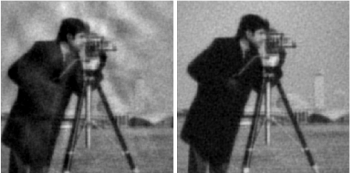
Recovery of enhanced depth-of-field image using wavefront coding results in phase-induced artifacts (left) that are not present with the new technique, complementary kernel matching (right). [Image: P. Zammit et al., Optica 1, 209 (2014)]
All photographers know the trade-off between depth-of-field (DOF) and numerical aperture: to get a snapshot in which objects both near and far are in focus, the photographer must “stop down” the lens opening, which allows in less light and limits resolution. A team of U.K.-based scientists now report a new hybrid imaging method that can overcome that paradox, recovering superior DOF that could sharpen up images ranging from snapshots to photomicrographs (Optica, doi: 10.1364/OPTICA.1.000209).
While not the first effort to enable digital DOF enhancement in otherwise unsharp images, the new technique appears to avoid visual artifacts that have plagued previous methods. The best-known of these techniques, wavefront coding (WC), was developed in 1995 by Edward Dowski and W. Thomas Cathey, and involves modifying the system optics to include a special waveplate in the imaging aperture. The waveplate introduces a cubic optical phase function that modifies the optical transfer function to be “focus invariant” with range; digital signal processing is then applied to bring the entire imaged object into focus at enhanced DOF. But WC, operating as it does via a phase modulation, can introduce phase mismatches, artifacts and noise into the resultant image, which subsequent refinements of the technique have not completely overcome.
To get past these artifacts, Paul Zammit and colleagues at the University of Glasgow have developed a new system, dubbed complementary kernel matching (CKM), that involves the simultaneous capture of two images with different cubic phase modulations. By numerically comparing and minimizing the apparent range-dependent translation between pixels in the two different images, CKM allows, according to the researchers, the recovery of an extended-DOF image without the phase artifacts associated with other techniques.
The technique was tested both in numerical simulations and in a proof-of-concept physical system, which proved able to recover sharp, artifact-free images in photomicrographs of biological specimens. The team is currently working on extending the system for use in snapshots and high-numerical-aperture imaging.
